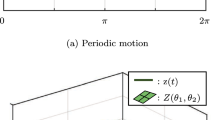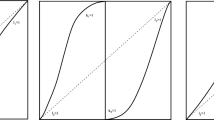Abstract
A model of dissipative quantum dynamics (with a nonlinear friction term) is applied to systems periodic in time. The model is compared with the standard approaches based on the Floquet theorem. It is shown that for weak frictions the asymptotic states of the dynamics we propose are the periodic steady states which are usually postulated to be the states relevant for the statistical mechanics of time-periodic systems. A solution to the problem of nonuniqueness of the “quasienergies” is proposed. The implication of a nonlinear evolution for Ludwig's axiomatization is briefly outlined.
Similar content being viewed by others
References
A. Abragam,The Principles of Nuclear Magnetism (Clarendon Press, Oxford, 1973).
A. G. Redfield,Phys. Rev. 98, 1787 (1955).
J. H. Shireley,Phys. Rev. 138B, 979 (1965).
R. H. Young and W. J. Deal,J. Math. Phys. 11, 3298 (1970).
H. Sambe,Phys. Rev. 7A, 2203 (1973).
Y. B. Zeldovich,Sov. Phys. Usp. 16, 427 (1973).
D. R. Dion and J. O. Hirschfelder,Adv. Chem. Phys. 35, 265 (1976).
G. Lochak and A. Alaoui,Ann. Fond. Louis de Broglie 2, 87 (1977).
O. Plaat,Ordinary Differential Equations (Holden-Day, San Francisco, 1971), or other books on differential equations.
G. Lochak,C.R. Acad. Sc. Paris,275B, 49, (1972);276B, 809 (1973).
N. Gisin,J. Phys. 14A, 2259 (1981).
N. Gisin, “Irreversible Quantum Dynamics and the Hilbert Space Structure of Quantum Kinematics,”J. Math. Phys. (1983), to appear.
F. Gesztesy and H. Mitter,J. Phys. 14A, L79 (1981).
M. H. Stone,Linear Transformations in Hilbert Space (American Mathematical Society, New York, 1966).
N. Gisin,Helv. Phys. Acta 54, 457 (1981); See alsoA Model of Dissipative Quantum Dynamics, Thesis, University of Geneva, 1982.
D. Guichon, G. Lochak, G. Theobald, and J. G. Theobald,C.R. Acad. Sc. (Paris) 274B, 935 (1972).
G. Lochak and A. Alaoui,C.R. Acad. Sc. (Paris) 282A, 1179 (1976).
R. P. Feynman,Phys. Rev. 84, 108 (1951).
G. S. Agarwal and E. Wolf,Phys. Rev. 2D, 2206 (1970).
E. B. Davies,Quantum Theory of Open Systems (Academic Press, London, 1976).
G. Ludwig, inInterpretations and Foundations of Quantum Theory, H. Neumann, ed. (B.I. Wissenschaftsverlag, Mannheim, 1981).
G. Ludwig, “Solved and Unsolved Problems in the Quantum Mechanics of Measurement,” inWerner Heisenberg und die Physik unserer Zeit, F. Bopp, ed. (Vieweg, Braunschweig, 1961).
N. Gisin and C. Piron,Lett. Math. Phys. 5, 379 (1981).
Author information
Authors and Affiliations
Rights and permissions
About this article
Cite this article
Gisin, N. Dissipative quantum dynamics for systems periodic in time. Found Phys 13, 643–654 (1983). https://doi.org/10.1007/BF01889346
Received:
Issue Date:
DOI: https://doi.org/10.1007/BF01889346




